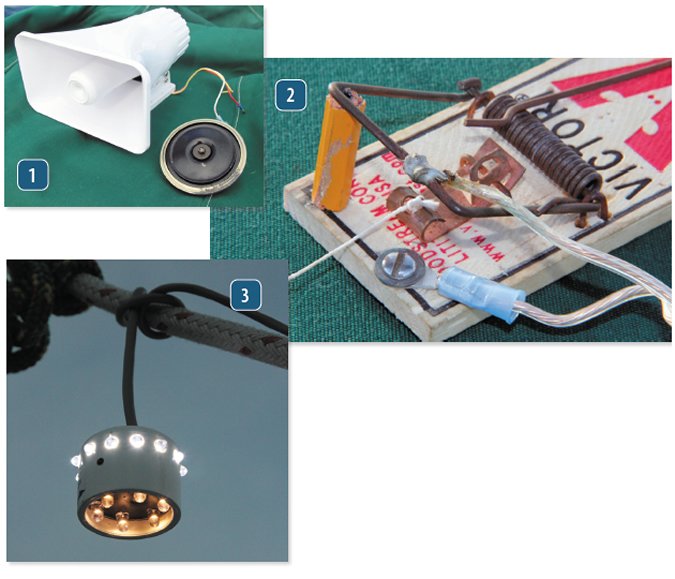
Some ports and anchorages are safer than others, but it never hurts to be cautious when it comes to boat security. When youre away from the boat, blasting a loud stereo down below can give the appearance that someone is onboard and may slow a prospective thief. (Doesnt everyone turn radios and TVs off when they leave?) Trailing a spare dinghy or kayak off the stern is also a good deterrent, as is on-deck illumination.
Modern LED lighting has such a minuscule power draw that cabin lights can be left on for 24 hours a day along with the stereo to keep would-be robbers at bay. A good solar panel will have no problem replacing the amperage. Arch-mounted LED anchor lights or an LED spreader light is well worth the expense in amperage to repel thieves. There are even darkness-sensing, combination anchor/cockpit lights-such as the one from Bebi Electronics (www.bebi-electronics.com)-that can be hung from the foredeck or cockpit and will come on with darkness and turn off with the sun.
To take your security measures a step further, you can install an alarm system. The problem with most store-bought, battery-operated, motion-sensing or magnetic alarms is that they are not much louder than a chirping cricket. They are not very scary to a thief who is determined to break into a boat, so we came up with our own, much louder alarm system.
When we had to leave our boat unoccupied on a mooring in a foreign port (Majuro, Marshall Islands) for an extended time, what saved our boat from intruders was our final line of defense, which we named the IMD, or Improvised Mousetrap Device.
In the event a thief breaches our boats companionway hatch and lifts up the top hatch board, he would be pulling on a trip line made of thin sail thread that is screwed to the bottom of the board. At the other end of the thread is a mousetrap. Once the trip lines 4 inches of slack are pulled taught, the mousetrap slaps shut. This trip mechanism (the trap) activates two audible alarms: a most piercing, 122-decibel siren camouflaged in the cockpit and a truck horn mounted in the cabin in an open port light facing into the cockpit. These noise blasters are hidden from view by a plastic bag and coils of lines.
We like the redundancy of the two horns. In case of malfunction or the thief discovering the siren in the cockpit, the interior horn will still blast. Plus, the mega-decibel blast of high- and low-range frequencies covers a full-audio effect across the mooring field and the nearby city waterfront.
To construct the alarm system, we soldered the horns positive wire to the movable jaw of the trap and screwed its corresponding wire to the wood base, so a circuit was complete when the trap was sprung. The loud horns were hard wired and fused into our 640-amp-hour battery bank. Installing these traps required calculating for the proper wire size so the length of wire needed would feed plenty of high-powered amperage to the horns.
We also installed another mousetrap circuit under the forward saloon hatch, which we left propped open for ventilation; the dinghy, stowed upside down on deck, served as a cover. We ran trip lines to the handles inside the dinghy, and a third trip line ran from this same mousetrap to the forepeak, where it was tied to a cushion that was tightly wedged below the hatch.
On our 34th day away from the boat, at 1:30 in the morning, the anchorage and the Majuro waterfront, were awakened by screeching sirens and horns blasting from our boat. The loud alarms were soon silenced, and the traps were reset by a cruising friend who knew our setup, but the IMD saved our boat from damage and theft.
If youre interested in setting up your own IMD, trip lines can be set across the sidedeck or tied to fuel jugs. There are incalculable ways to use an IMD to protect your boat and equipment and to scare the coconuts out of local thieves-and all their relatives on shore.


































